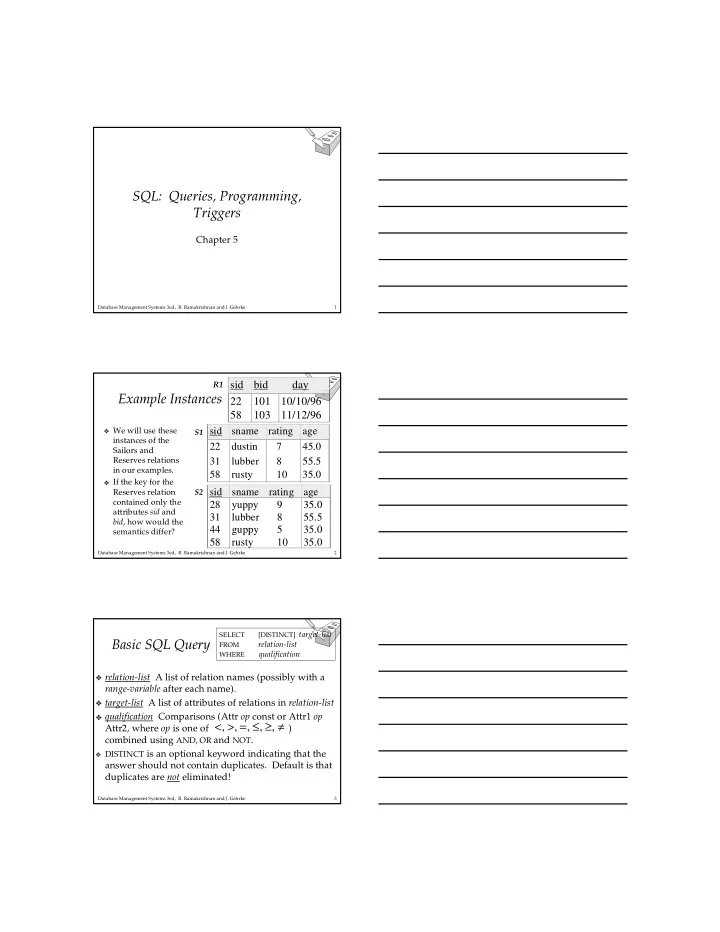

✁ � ✁ ✁ � � SQL:��Queries,�Programming,� Triggers Chapter�5 Database�Management�Systems�3ed,��R. Ramakrishnan and�J.�Gehrke 1 sid bid day R1 22 101 10/10/96 Example�Instances 58 103 11/12/96 sid sname rating age We�will�use�these� S1 instances�of�the� 22 dustin 7 45.0 Sailors�and� 31 lubber 8 55.5 Reserves�relations� in�our�examples. 58 rusty 10 35.0 If�the�key�for�the� sid sname rating age Reserves�relation� S2 28 yuppy 9 35.0 contained�only�the� attributes sid and� 31 lubber 8 55.5 bid ,�how�would�the� 44 guppy 5 35.0 semantics�differ? 58 rusty 10 35.0 Database�Management�Systems�3ed,��R. Ramakrishnan and�J.�Gehrke 2 SELECT��������[DISTINCT]�� target-list Basic�SQL�Query relation-list FROM WHERE�������� qualification relation-list A�list�of�relation�names�(possibly�with�a� range-variable after�each�name). target-list A�list�of�attributes�of�relations�in� relation-list qualification Comparisons�(Attr op const�or�Attr1� op < > = ≤ ≥ ≠ , , , , , Attr2,�where� op is�one�of���������������������������������)�� combined�using� AND,�OR� and� NOT . DISTINCT is�an�optional�keyword�indicating�that�the� answer�should�not�contain�duplicates.��Default�is�that� duplicates�are� not eliminated!�� Database�Management�Systems�3ed,��R. Ramakrishnan and�J.�Gehrke 3
� � ✁ � ✁ � ✁ Conceptual�Evaluation�Strategy Semantics�of�an�SQL�query�defined�in�terms�of�the� following�conceptual�evaluation�strategy: Compute�the�cross-product�of� relation-list . Discard�resulting tuples if�they�fail� qualifications . Delete�attributes�that�are�not�in� target-list . If� DISTINCT is�specified,�eliminate�duplicate�rows. This�strategy�is�probably�the�least�efficient�way�to� compute�a�query!��An�optimizer�will�find�more� efficient�strategies�to�compute� the�same�answers . Database�Management�Systems�3ed,��R. Ramakrishnan and�J.�Gehrke 4 Example�of�Conceptual�Evaluation SELECT S.sname FROM����� Sailors�S,�Reserves�R WHERE S.sid=R.sid AND R.bid=103 (sid) sname rating age (sid) bid day 22 dustin 7 45.0 22 101 10/10/96 22 dustin 7 45.0 58 103 11/12/96 31 lubber 8 55.5 22 101 10/10/96 31 lubber 8 55.5 58 103 11/12/96 58 rusty 10 35.0 22 101 10/10/96 58 rusty 10 35.0 58 103 11/12/96 Database�Management�Systems�3ed,��R. Ramakrishnan and�J.�Gehrke 5 A�Note�on�Range�Variables Really�needed�only�if�the�same�relation� appears�twice�in�the� FROM clause.��The� previous�query�can�also�be�written�as: SELECT S.sname It�is�good�style, FROM����� Sailors�S,�Reserves�R however,�to�use WHERE S.sid=R.sid AND bid=103 range�variables OR SELECT sname always! FROM����� Sailors,�Reserves� WHERE Sailors.sid=Reserves.sid AND bid=103 Database�Management�Systems�3ed,��R. Ramakrishnan and�J.�Gehrke 6
� ✁ � ✁ ✁ � � � Find�sailors�who’ve�reserved�at�least�one�boat SELECT S.sid FROM Sailors�S,�Reserves�R WHERE S.sid=R.sid Would�adding� DISTINCT� to�this�query�make�a� difference? What�is�the�effect�of�replacing� S.sid by� S.sname in� the� SELECT clause?��Would�adding� DISTINCT to� this�variant�of�the�query�make�a�difference? Database�Management�Systems�3ed,��R. Ramakrishnan and�J.�Gehrke 7 Expressions�and�Strings SELECT S.age,�age1=S.age-5,�2*S.age� AS age2 FROM Sailors�S WHERE S.sname LIKE� ‘B_%B’ Illustrates�use�of�arithmetic�expressions�and�string� pattern�matching:�� Find�triples�(of�ages�of�sailors�and� two�fields�defined�by�expressions)�for�sailors�whose�names� begin�and�end�with�B�and�contain�at�least�three�characters. AS and�= are�two�ways�to�name�fields�in�result. LIKE is�used�for�string�matching.�`_’�stands�for�any� one�character�and�`%’�stands�for�0�or�more�arbitrary� characters.�� Database�Management�Systems�3ed,��R. Ramakrishnan and�J.�Gehrke 8 Find sid’s of�sailors�who’ve�reserved�a�red�or a�green�boat UNION :�Can�be�used�to� SELECT S.sid FROM Sailors�S,�Boats�B,�Reserves�R compute�the�union�of�any� WHERE� S.sid=R.sid AND R.bid=B.bid two� union-compatible sets�of AND (B.color=‘red’� OR B.color=‘green’) tuples (which�are� themselves�the�result�of� SQL�queries). SELECT S.sid If�we�replace� OR by� AND in� FROM�� Sailors�S,�Boats�B,�Reserves�R the�first�version,�what�do� WHERE S.sid=R.sid AND R.bid=B.bid we�get? AND B.color=‘red’ UNION Also�available:�� EXCEPT SELECT S.sid (What�do�we�get�if�we� FROM�� Sailors�S,�Boats�B,�Reserves�R replace� UNION by� EXCEPT ?) WHERE S.sid=R.sid AND R.bid=B.bid AND B.color=‘green’ Database�Management�Systems�3ed,��R. Ramakrishnan and�J.�Gehrke 9
✁ � � ✁ ✁ � ✁ ✁ � Find sid’s of�sailors�who’ve�reserved�a�red�and a�green�boat SELECT S.sid FROM Sailors�S,�Boats�B1,�Reserves�R1, INTERSECT :�Can�be�used�to� Boats�B2,�Reserves�R2 WHERE� S.sid=R1.sid AND R1.bid=B1.bid compute�the�intersection� AND�� S.sid=R2.sid AND R2.bid=B2.bid of�any�two�� union- AND (B1.color=‘red’� AND B2.color=‘green’) compatible sets�of tuples.� Key�field! Included�in�the�SQL/92� SELECT S.sid standard,�but�some� FROM�� Sailors�S,�Boats�B,�Reserves�R WHERE S.sid=R.sid AND R.bid=B.bid systems�don’t�support�it. AND B.color=‘red’ Contrast�symmetry�of�the� INTERSECT UNION and� INTERSECT� SELECT S.sid FROM�� Sailors�S,�Boats�B,�Reserves�R queries�with�how�much� WHERE S.sid=R.sid AND R.bid=B.bid the�other�versions�differ. AND B.color=‘green’ Database�Management�Systems�3ed,��R. Ramakrishnan and�J.�Gehrke 10 Nested�Queries Find�names�of�sailors�who’ve�reserved�boat�#103: SELECT� S.sname FROM Sailors�S WHERE� S.sid IN ( SELECT R.sid FROM Reserves�R WHERE R.bid=103) A�very�powerful�feature�of�SQL:��a� WHERE clause�can� itself�contain�an�SQL�query!��(Actually,�so�can� FROM and� HAVING clauses.) To�find�sailors�who’ve� not reserved�#103,�use� NOT�IN . To�understand�semantics�of�nested�queries,�think�of�a� nested�loops evaluation:�� For�each�Sailors tuple,�check�the� qualification�by�computing�the subquery. Database�Management�Systems�3ed,��R. Ramakrishnan and�J.�Gehrke 11 Nested�Queries�with�Correlation Find�names�of�sailors�who’ve�reserved�boat�#103: SELECT� S.sname FROM Sailors�S WHERE���EXISTS ( SELECT * FROM Reserves�R WHERE R.bid=103� AND S.sid=R.sid) EXISTS is�another�set�comparison�operator,�like� IN .�� If� UNIQUE is�used,�and�*�is�replaced�by� R.bid ,�finds� sailors�with�at�most�one�reservation�for�boat�#103.�� ( UNIQUE checks�for�duplicate tuples;�*�denotes�all� attributes.��Why�do�we�have�to�replace�*�by� R.bid ?) Illustrates�why,�in�general, subquery must�be�re- computed�for�each�Sailors tuple. Database�Management�Systems�3ed,��R. Ramakrishnan and�J.�Gehrke 12
Recommend
More recommend